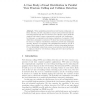Free Online Productivity Tools
i2Speak
i2Symbol
i2OCR
iTex2Img
iWeb2Print
iWeb2Shot
i2Type
iPdf2Split
iPdf2Merge
i2Bopomofo
i2Arabic
i2Style
i2Image
i2PDF
iLatex2Rtf
Sci2ools
EUROPAR
2001
Springer
2001
Springer
A Case Study of Load Distribution in Parallel View Frustum Culling and Collision Detection
Abstract. When parallelizing hierarchical view frustum culling and collision detection, the low computation cost per node and the fact that the traversal path through the tree structure is not known `a priori make the classical load-balance versus communication tradeoff very challenging. In this paper, a comparative performance evaluation of a number of load distribution strategies is conducted. We show that several strategies suffer from a too high an orchestration overhead to provide any meaningful speedup. However, by applying some straightforward tricks to get rid of most of the locking needed, it is possible to achieve interesting speedups. For our industrially related test scenes, we get about a four-fold speedup on eight processors for view frustum culling and three times speedup for collision detection.
Collision Detection | Distributed And Parallel Computing | EUROPAR 2001 | Four-fold Speedup | View Frustum Culling |
| Added | 28 Jul 2010 |
| Updated | 28 Jul 2010 |
| Type | Conference |
| Year | 2001 |
| Where | EUROPAR |
| Authors | Ulf Assarsson, Per Stenström |
Comments (0)

